MeeGo 2010: Free Transformers, Upstream 1st, the upcoming MeeGo-smartphones and the inevitable competition
First of all, many thanks to everyone who left comments on my post about the first day of the MeeGo 2010 Conference in Dublin; those who read the first note , but did not see most of the comments - please pay attention to them; I think we had a rather interesting discussion there.
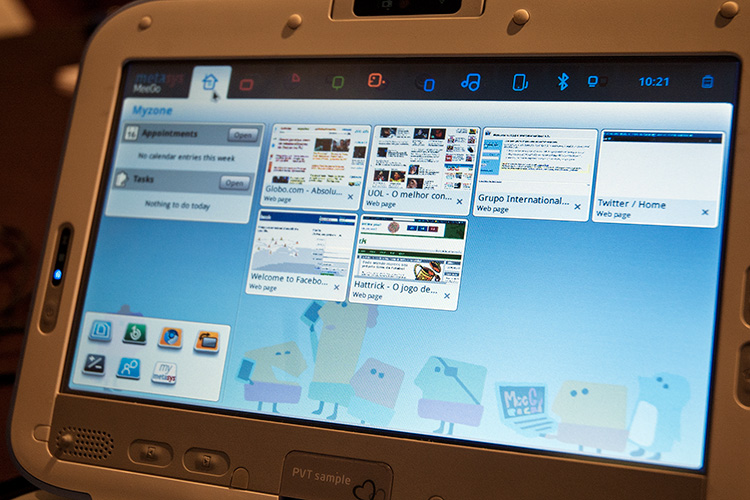
One of the exhibits undeservedly overlooked by the exhibition is the Intel school classmate PC netbook with the specialized assembly of the Brazilian company MetaSys installed on it.
The second day of the conference opened with an attraction of unprecedented generosity - the conference partner company Lenovo brought a crazy amount of sensory transformer netbooks IdeaPad S10-3t and distributed them to all conference participants; all you had to do was to appear in the media center of the conference, show a badge, take one of the suggested installation flash drives, pull down the Windows 7 netbook preinstalled and put MeeGo on; The procedure consists of approximately six touches of the screen and five minutes of time.
')
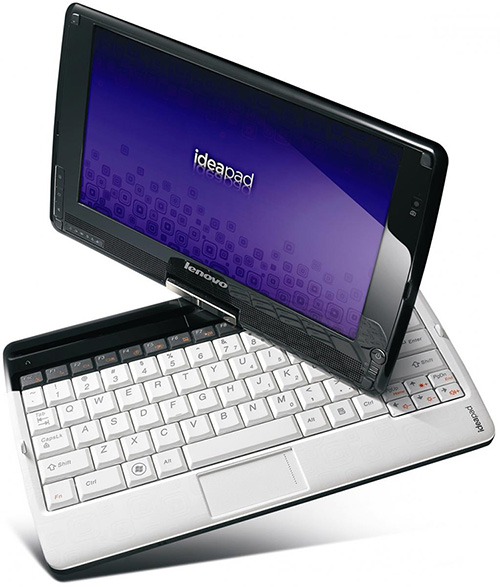
Such a thing is this IdeaPad.
I did not have any sessions in the morning, so I went to my place - this is a pretty, albeit a little girl (plastic with sparkles) netbook with a swiveling touch screen; inside - Atom N470, 2 gigabytes of RAM and 250 GB hard drive. I do not have a penchant for gear porn, but S10-3t makes a pleasant impression - the screen is bright, clear and contrast, it weighs a little more than the iPad, but most importantly, MeeGo 1.1 flies on it. Finnish lady Susanna, who was sitting next to me, suggested that the matter is in using a graphics accelerator, but the fact remains that interface 1.1 on this device works with surprising smoothness, which is more common for users of devices from a well-known fruit company. Things are easy - to figure out whether it is possible to install applications in 1.1 in some more convenient way than through a rather geeky package manager.
A curious moment - at the entrance to the media center, everyone was offered a choice of two distributions of MeeGo 1.1. In one was built Broadcom network driver, proprietary, but 100% working. In another, this driver was open source, but its full-fledged work was not guaranteed. It is a religious question, as you understand. Coming out of the media center, I heard a conversation between two organizers of the attraction of generosity - they discussed the fact that the overwhelming number of visitors, in principle, participating in the open source conference, chose a proprietary driver. As you can see, even a very specific, technically savvy audience prefers primarily a workable product; the extent to which he is “racially faithful” turns out to be a very secondary consideration.
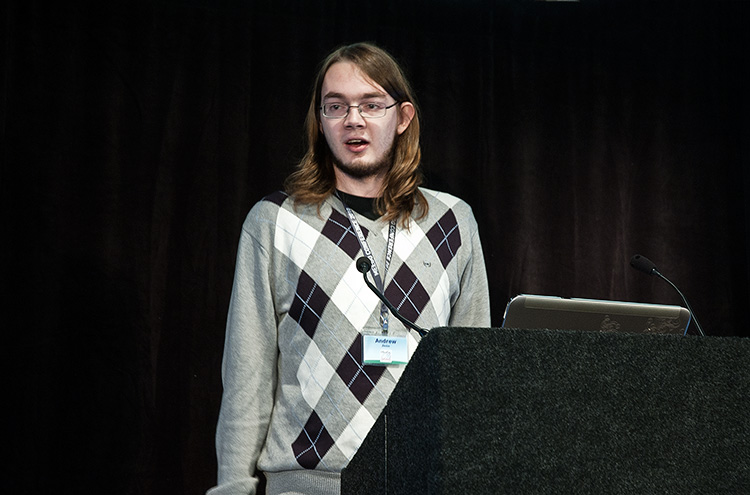
Andrei Zhilin sends greetings to Argaylovskiy diamonds and conference participants.
Today the Russians performed; Andrei Zhilin, whom I presented yesterday, read a very informal and ridiculous, but, as it seemed to me, an extremely useful lecture about how a savvy developer can do without an interface designer. He mentioned all the usual suspects - useful in the household human interface guidelines, fonts, resources with pretty icons, Adobe Kuler for quick selection of specious color combinations and the main mistakes that developers make when they start to deal with interfaces.
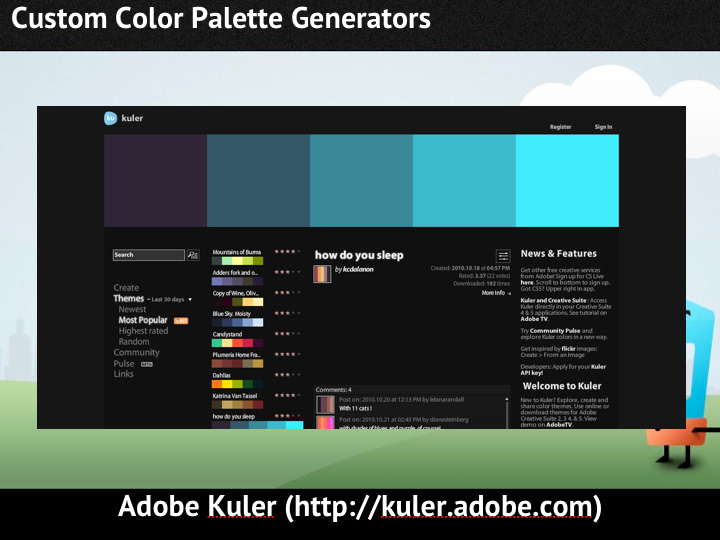
Several of today's sessions dealt with the MeeGo interface for mobile phones; For example, Mikko Levonmya and Tuomas Järvevenscha from Nokia talked about how they are working on the appearance and functionality of the home screen:

The MeeGo interface for smartphones is one of the hottest topics of the conference - a later session, at which more senior Nokia engineers discussed the future of the MeeGo Handheld UI, was generally crowded - people dragged chairs from the next room and stood in the aisles. I was late for it, but I took business cards from Nokia engineers who promised to answer all the questions they have the right to answer according to corporate policy.
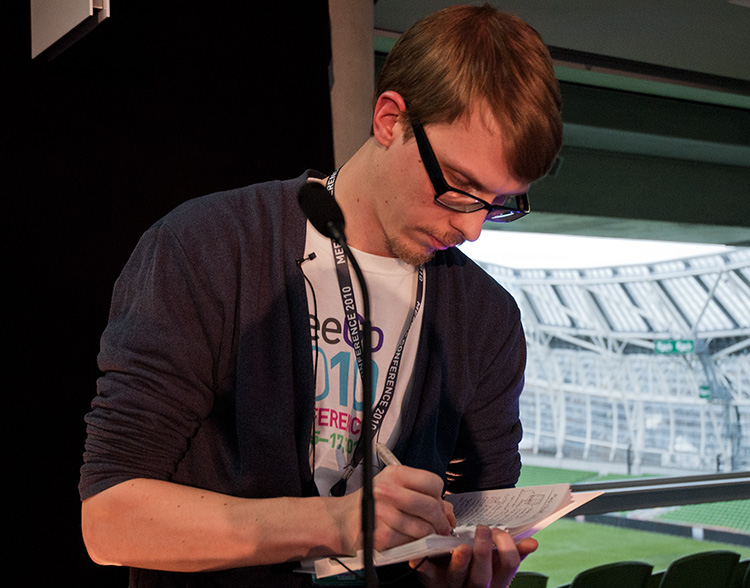
Tuomas leaves its coordinates.
From the lecture by Mikko and Tuomas it becomes clear that the interface is still in operation, and the work is well underway, but many strategic decisions have not yet been made on it:

Personally, such a calm and balanced approach is very close to me - the development can be lengthy, but the solutions found in its course should be very good. Using a netbook, especially if it is a second or even a third computer, you can also use the beta version of the operating system, but the beta firmware of the phone is something not very viable - we need to call friends and family, and not “test opportunities” , true?

Tuomas shared his slides; in particular, this shows where it is possible to monitor the development status of the interface, and where it is possible (attention!) to join its development. After the session, the guys with Tuomas and Mikko came up with suggestions for improving the home screen, and the guys from Nokia said they would be happy if more people joined what they were doing. So if you want to influence how the future interfaces of smartphones based on MeeGo will look like, just join them in developing.
One of the key moments of the MeeGo community, which became obvious to me only at the conference, is the concept of Upstream 1 st . She was told at the introductory word, and I decided by inertia that this was some kind of another beautiful marketing term, not very suitable for life, but no - the developers in reports and personal conversations with visible pleasure mention Upstream 1 st as the main driving force of the community MeeGo. In short, this term describes the overall flow of development, which is at the very first place in the ideology of MeeGo. Community members make sure that the operating system and its many components do not spill over into a bunch of individual development branches that are rather difficult to maintain. If a typical * NIX-community is more like the shoots of exotic shrubs, then MeeGo wants to be pine, straight and level. The code is taken from the community, processed and returned back in the most accurate way - in order to make life easier for all participants in the process. I will once again give a link to my note on the first day , where I added a few comments by Dominique Le Voll; his project Freedom is the most vivid and practical evidence of the Upstream 1 st concept in action; it becomes obvious that Upstream 1 st really works and benefits all participants in the process - in the case of Dominic and his team, this benefit turns into a specie, without which the existence of a very competitive set-top box is simply impossible. I will refrain from translating the article, but I4U very well retold the main content of the introductory word of the conference in relation to Upstream 1 st .

Vyacheslav Chernikov.
In the afternoon, I took a moment, caught my companion Vyacheslav Chernikov, took him to take a picture and asked about what he was doing and what he thought about the conference. Here is what Vyacheslav told me:
“I am from Voronezh. I am engaged in software development for mobile platforms, first of all these are Qt-based development for Symbian and MeeGo. The project that we are finishing now is Geeky Avatar , a program for creating avatars. Now we are working on the design, exploring how to improve the program interface and make it simpler and more beautiful.
It is very interesting to be in a large international community of people who are interested in Linux and its application to the development of IVI and mobile platforms. Now a large number of companies are going around the MeeGo platform; I think if you spend so much time and money on a product, then, most likely, you will get something whole and really worthwhile. With each new release, the platform becomes more interesting, more stable and more functional.
From the moment I started studying Qt, the possibility of certification appeared, and at this conference I plan to pass all three exams. The results will be known a little later, but now for me it is an opportunity to see how the certification goes. It's nice that two of the three exams are free. ”
Vyacheslav is right - and the certification held at the conference, and daily valuable prizes, and the plot with IdeaPad - all this shows the amount of attention and money invested by the main sponsors of the project in MeeGo in the hope that the platform will take place - and it seems so far they have done it very well.
Intel practically does not pedal at the conference itself - somewhere in the far corner of the hall there is a very modest logo, on the back of the information desk there is an equally modest booth, and that an engineer conducting a session works at Intel, you usually find out on the last slide of his presentation from his email address. While there is a reason, I will tell about one of the contests, which directly concerns not only the visitors of the conference, but all those who wish to go far beyond the community - the “asked to post” column.

Goals!
Intel's extreme stand booth at the conference - the screen with the game Goals! Few people know that this is the winning game for the Intel AppUp Store application developer - its author Rick Vanner, along with his team The Game Creators, transferred the existing football game for iOS to the Intel AppUp application store in Windows and Moblin and won the luxury electric Chevy Volt (and this is for a minute the equivalent of $ 60,000). Awarding the Rick Prize was one of the high-profile events at the recent Intel Developer Forum; Details on all this can be found in a friendly blog .
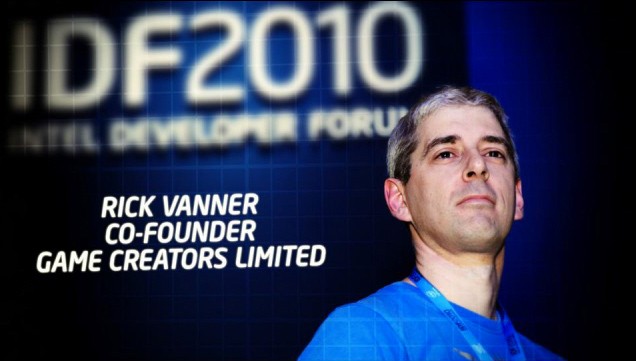
However, Goals! This is by no means the case - our Russian developer Dmitry Ryzhkov, aka terror from Tolyatti, has now won two prizes for the total amount of $ 30,000 with My Little Artist application. My Little Artist is a drawing program that Dmitry conceived as a drawing tool for his little son - again, you can read the details in the spring interview with Dmitry .
In short, the competition works and is in full swing; I asked Vyacheslav - he is also going to take part in it; in general, after a survey of interested parties, it seems that a decent number of teams that do not publicly advertise their participation in secretly participate in it - apparently, so as not to frighten luck. Several nominations of the competition have already been closed, but there are two main prizes in turn - for the most innovative application (a trip to Germany for a BMW or the equivalent of $ 60,000) and an audience award (some kind of super-trip or $ 60,000 too).
Tomorrow is the third, last day of the conference, called Unconference. This is an inverse role-playing game - students offer their own topics for performances, complete the grid and then perform with them. I plan to join and gently continue the topic of Andrei Zilin; if you have questions for the conference participants, do not hesitate to ask them, I will, as far as possible, catch interesting participants and take comments from them.
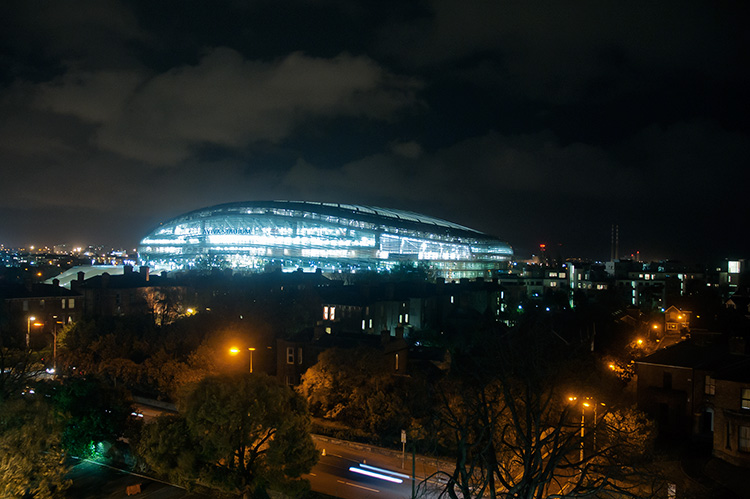

One of the exhibits undeservedly overlooked by the exhibition is the Intel school classmate PC netbook with the specialized assembly of the Brazilian company MetaSys installed on it.
The second day of the conference opened with an attraction of unprecedented generosity - the conference partner company Lenovo brought a crazy amount of sensory transformer netbooks IdeaPad S10-3t and distributed them to all conference participants; all you had to do was to appear in the media center of the conference, show a badge, take one of the suggested installation flash drives, pull down the Windows 7 netbook preinstalled and put MeeGo on; The procedure consists of approximately six touches of the screen and five minutes of time.
')

Such a thing is this IdeaPad.
I did not have any sessions in the morning, so I went to my place - this is a pretty, albeit a little girl (plastic with sparkles) netbook with a swiveling touch screen; inside - Atom N470, 2 gigabytes of RAM and 250 GB hard drive. I do not have a penchant for gear porn, but S10-3t makes a pleasant impression - the screen is bright, clear and contrast, it weighs a little more than the iPad, but most importantly, MeeGo 1.1 flies on it. Finnish lady Susanna, who was sitting next to me, suggested that the matter is in using a graphics accelerator, but the fact remains that interface 1.1 on this device works with surprising smoothness, which is more common for users of devices from a well-known fruit company. Things are easy - to figure out whether it is possible to install applications in 1.1 in some more convenient way than through a rather geeky package manager.
A curious moment - at the entrance to the media center, everyone was offered a choice of two distributions of MeeGo 1.1. In one was built Broadcom network driver, proprietary, but 100% working. In another, this driver was open source, but its full-fledged work was not guaranteed. It is a religious question, as you understand. Coming out of the media center, I heard a conversation between two organizers of the attraction of generosity - they discussed the fact that the overwhelming number of visitors, in principle, participating in the open source conference, chose a proprietary driver. As you can see, even a very specific, technically savvy audience prefers primarily a workable product; the extent to which he is “racially faithful” turns out to be a very secondary consideration.

Andrei Zhilin sends greetings to Argaylovskiy diamonds and conference participants.
Today the Russians performed; Andrei Zhilin, whom I presented yesterday, read a very informal and ridiculous, but, as it seemed to me, an extremely useful lecture about how a savvy developer can do without an interface designer. He mentioned all the usual suspects - useful in the household human interface guidelines, fonts, resources with pretty icons, Adobe Kuler for quick selection of specious color combinations and the main mistakes that developers make when they start to deal with interfaces.

Several of today's sessions dealt with the MeeGo interface for mobile phones; For example, Mikko Levonmya and Tuomas Järvevenscha from Nokia talked about how they are working on the appearance and functionality of the home screen:

The MeeGo interface for smartphones is one of the hottest topics of the conference - a later session, at which more senior Nokia engineers discussed the future of the MeeGo Handheld UI, was generally crowded - people dragged chairs from the next room and stood in the aisles. I was late for it, but I took business cards from Nokia engineers who promised to answer all the questions they have the right to answer according to corporate policy.

Tuomas leaves its coordinates.
From the lecture by Mikko and Tuomas it becomes clear that the interface is still in operation, and the work is well underway, but many strategic decisions have not yet been made on it:

Personally, such a calm and balanced approach is very close to me - the development can be lengthy, but the solutions found in its course should be very good. Using a netbook, especially if it is a second or even a third computer, you can also use the beta version of the operating system, but the beta firmware of the phone is something not very viable - we need to call friends and family, and not “test opportunities” , true?

Tuomas shared his slides; in particular, this shows where it is possible to monitor the development status of the interface, and where it is possible (attention!) to join its development. After the session, the guys with Tuomas and Mikko came up with suggestions for improving the home screen, and the guys from Nokia said they would be happy if more people joined what they were doing. So if you want to influence how the future interfaces of smartphones based on MeeGo will look like, just join them in developing.
One of the key moments of the MeeGo community, which became obvious to me only at the conference, is the concept of Upstream 1 st . She was told at the introductory word, and I decided by inertia that this was some kind of another beautiful marketing term, not very suitable for life, but no - the developers in reports and personal conversations with visible pleasure mention Upstream 1 st as the main driving force of the community MeeGo. In short, this term describes the overall flow of development, which is at the very first place in the ideology of MeeGo. Community members make sure that the operating system and its many components do not spill over into a bunch of individual development branches that are rather difficult to maintain. If a typical * NIX-community is more like the shoots of exotic shrubs, then MeeGo wants to be pine, straight and level. The code is taken from the community, processed and returned back in the most accurate way - in order to make life easier for all participants in the process. I will once again give a link to my note on the first day , where I added a few comments by Dominique Le Voll; his project Freedom is the most vivid and practical evidence of the Upstream 1 st concept in action; it becomes obvious that Upstream 1 st really works and benefits all participants in the process - in the case of Dominic and his team, this benefit turns into a specie, without which the existence of a very competitive set-top box is simply impossible. I will refrain from translating the article, but I4U very well retold the main content of the introductory word of the conference in relation to Upstream 1 st .

Vyacheslav Chernikov.
In the afternoon, I took a moment, caught my companion Vyacheslav Chernikov, took him to take a picture and asked about what he was doing and what he thought about the conference. Here is what Vyacheslav told me:
“I am from Voronezh. I am engaged in software development for mobile platforms, first of all these are Qt-based development for Symbian and MeeGo. The project that we are finishing now is Geeky Avatar , a program for creating avatars. Now we are working on the design, exploring how to improve the program interface and make it simpler and more beautiful.
It is very interesting to be in a large international community of people who are interested in Linux and its application to the development of IVI and mobile platforms. Now a large number of companies are going around the MeeGo platform; I think if you spend so much time and money on a product, then, most likely, you will get something whole and really worthwhile. With each new release, the platform becomes more interesting, more stable and more functional.
From the moment I started studying Qt, the possibility of certification appeared, and at this conference I plan to pass all three exams. The results will be known a little later, but now for me it is an opportunity to see how the certification goes. It's nice that two of the three exams are free. ”
Vyacheslav is right - and the certification held at the conference, and daily valuable prizes, and the plot with IdeaPad - all this shows the amount of attention and money invested by the main sponsors of the project in MeeGo in the hope that the platform will take place - and it seems so far they have done it very well.
Intel practically does not pedal at the conference itself - somewhere in the far corner of the hall there is a very modest logo, on the back of the information desk there is an equally modest booth, and that an engineer conducting a session works at Intel, you usually find out on the last slide of his presentation from his email address. While there is a reason, I will tell about one of the contests, which directly concerns not only the visitors of the conference, but all those who wish to go far beyond the community - the “asked to post” column.

Goals!
Intel's extreme stand booth at the conference - the screen with the game Goals! Few people know that this is the winning game for the Intel AppUp Store application developer - its author Rick Vanner, along with his team The Game Creators, transferred the existing football game for iOS to the Intel AppUp application store in Windows and Moblin and won the luxury electric Chevy Volt (and this is for a minute the equivalent of $ 60,000). Awarding the Rick Prize was one of the high-profile events at the recent Intel Developer Forum; Details on all this can be found in a friendly blog .

However, Goals! This is by no means the case - our Russian developer Dmitry Ryzhkov, aka terror from Tolyatti, has now won two prizes for the total amount of $ 30,000 with My Little Artist application. My Little Artist is a drawing program that Dmitry conceived as a drawing tool for his little son - again, you can read the details in the spring interview with Dmitry .
In short, the competition works and is in full swing; I asked Vyacheslav - he is also going to take part in it; in general, after a survey of interested parties, it seems that a decent number of teams that do not publicly advertise their participation in secretly participate in it - apparently, so as not to frighten luck. Several nominations of the competition have already been closed, but there are two main prizes in turn - for the most innovative application (a trip to Germany for a BMW or the equivalent of $ 60,000) and an audience award (some kind of super-trip or $ 60,000 too).
Tomorrow is the third, last day of the conference, called Unconference. This is an inverse role-playing game - students offer their own topics for performances, complete the grid and then perform with them. I plan to join and gently continue the topic of Andrei Zilin; if you have questions for the conference participants, do not hesitate to ask them, I will, as far as possible, catch interesting participants and take comments from them.

Source: https://habr.com/ru/post/108297/
All Articles